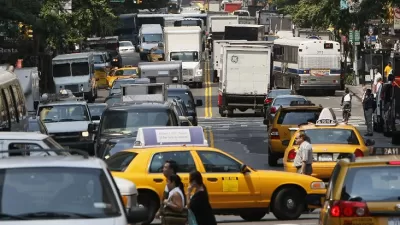The city's plan to charge vehicles entering Manhattan's central business district could reduce traffic and raise $1 billion a year for the city's transportation infrastructure.

In an op-ed in the New York Daily News, Betsy Plum and Kate Slevin argue that New York City's long-awaited plan to institute congestion pricing for vehicles entering Manhattan's central business district is "a welcome milestone" for a strong regional recovery.
"Now that the doors are open for quick action, the MTA should immediately begin determining the nuts and bolts of what New York’s program looks like — fixing how much tolls will cost, whether they’ll vary by time of day, who pays what," write Plum and Slevin. The authors contend that, "[w]ith forward thinking and hard work that starts now," the city could start its program and start earning revenue in as little as a year.
If instituted, the program would follow in the footsteps of London, Singapore, Stockholm, and other traffic-choked cities. "Congestion pricing is projected to raise about $1 billion annually for new subway signals, cars, elevators, buses and commuter rail. It will alleviate congestion worth an estimated $20 billion annually to residents." Additionally, the reduced traffic could lead to faster buses, "quicker emergency response times, less pollution, fewer carbon emissions, less chance of deadly collisions, less of a burden on businesses and customers and less stress for businesses, drivers, commuters and residents."
FULL STORY: Congestion pricing, more than ever

Planetizen Federal Action Tracker
A weekly monitor of how Trump’s orders and actions are impacting planners and planning in America.

San Francisco's School District Spent $105M To Build Affordable Housing for Teachers — And That's Just the Beginning
SFUSD joins a growing list of school districts using their land holdings to address housing affordability challenges faced by their own employees.

The Tiny, Adorable $7,000 Car Turning Japan Onto EVs
The single seat Mibot charges from a regular plug as quickly as an iPad, and is about half the price of an average EV.

San Diego Votes to Rein in “Towering” ADUs
City council voted to limit the number of units in accessory buildings to six — after confronting backyard developments of up to 100 units behind a single family home.

Texas Legislature’s Surprising Pro-Housing Swing
Smaller homes on smaller lots, office to apartment conversions, and 40% less say for NIMBYs, vote state lawmakers.

Even Edmonton Wants Single Staircase Buildings
Canada's second most affordable major city joins those angling to nix the requirement for two staircases in multi-family buildings.
Urban Design for Planners 1: Software Tools
This six-course series explores essential urban design concepts using open source software and equips planners with the tools they need to participate fully in the urban design process.
Planning for Universal Design
Learn the tools for implementing Universal Design in planning regulations.
Borough of Carlisle
Smith Gee Studio
City of Camden Redevelopment Agency
City of Astoria
Transportation Research & Education Center (TREC) at Portland State University
City of Camden Redevelopment Agency
Municipality of Princeton (NJ)





























